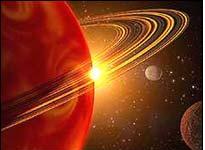Astronomers estimate that at least half of the solar systems discovered so far in our galaxy may contain Earth-like worlds. They also say that a space telescope will be able to observe them and study them to see if there is indeed life in them, within 15 years
In the picture: over a hundred gas giants were discovered in the last decade (simulation)
It is estimated that at least half of the solar systems discovered so far in our galaxy may contain Earth-like worlds. They also say that a space telescope will be able to observe them and study them to see if there is indeed life in them, within 15 years.
As mentioned, the scientists discovered more than a hundred planets around other suns, however, most of the stars that were discovered are gas giants such as Jupiter that cannot serve as a home for life. It is almost certain that planets at least similar in size to Earth also exist in many of these systems but are too small to be seen with current technologies.
Researchers at Britain's Open University estimate that there are about 50 small planets, rocky bodies where liquid water exists and possibly life.
"We can expect with absolute certainty that they will be more or less the size and mass of Earth, so that they have a reasonable atmosphere, oceans and continents, and they have the potential to contain life as well, but the biggest question is, does life really exist there? said astronomer Prof. Barry Jones from the Open University.
His team used computer models to calculate the number of life-bearing planets, based on what we know about how planets form and the conditions necessary for life.
The planets will exist in what is called "the Goldilocks zone" or the strip of life, an area located at such a distance from the central star of the system where it is not too hot for water to remain in a liquid state and not too cold. By sending "Earths" to a variety of orbits within this strip and monitoring their development, it turned out that the small planets suffered a variety of fates.
The key in the atmosphere
In several cases, too close proximity to one or more of the Jupiter-like giant planets resulted in the gravitational ejection of "Earth" from every possible place in the life belt. However, in other cases there are safe havens in some parts of life, and in some cases, the entire life is safe.
Nine of the extrasolar planets were studied in detail using the technique, allowing the team to deduce the basic laws that characterize a planet's ability to harbor life in other systems. At this point, this is of course only a theory, but in the middle of the next decade we will be able to use the technology to directly search for Earth-like planets. The next generation of space telescopes will look for gases produced by living things in the atmospheres of distant worlds.
A distant wonder
Finding compounds like carbon dioxide, water and ozone can be unequivocal evidence of life. However, even if these chemical signs are discovered, it will be impossible to send a space mission there, Prof. Jones emphasizes.
"It is almost certain that the closest planet of the Earth's type, which is in the habitable zone of its star, may be tens of light years away, maybe even a hundred light years from us and this is an optimistic estimate," he said. "Today there is no ability to travel to these worlds. All we can do is rely on instruments orbiting the sun to make the observations.
"I believe we will be disappointed if we have indirect proof of the existence of life, but we cannot be sure of it and there is no way we can be completely sure in the foreseeable future." Prof. Jones noted, presenting the details of his work at the British National Astronomical Meeting in Milton Keynes.
This study is more optimistic than a study done by Dr. Kristen Menou of Princeton University in the USA last year in which he estimated that only a quarter of the discovered solar systems may have Earth-like planets.
For news at the BBC

